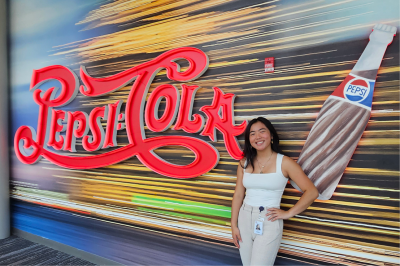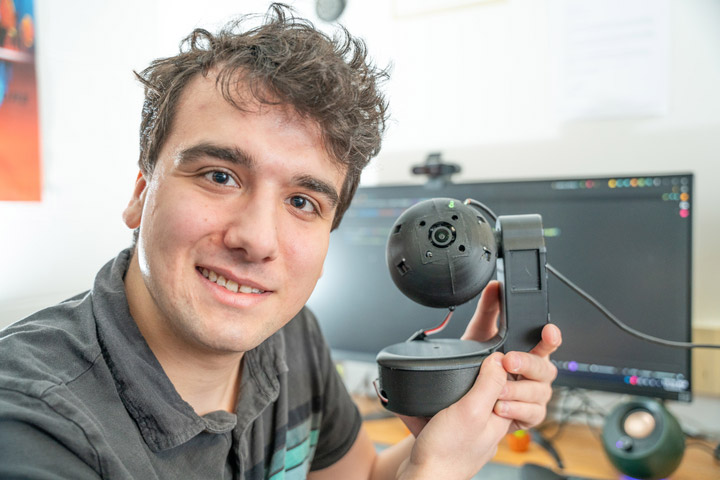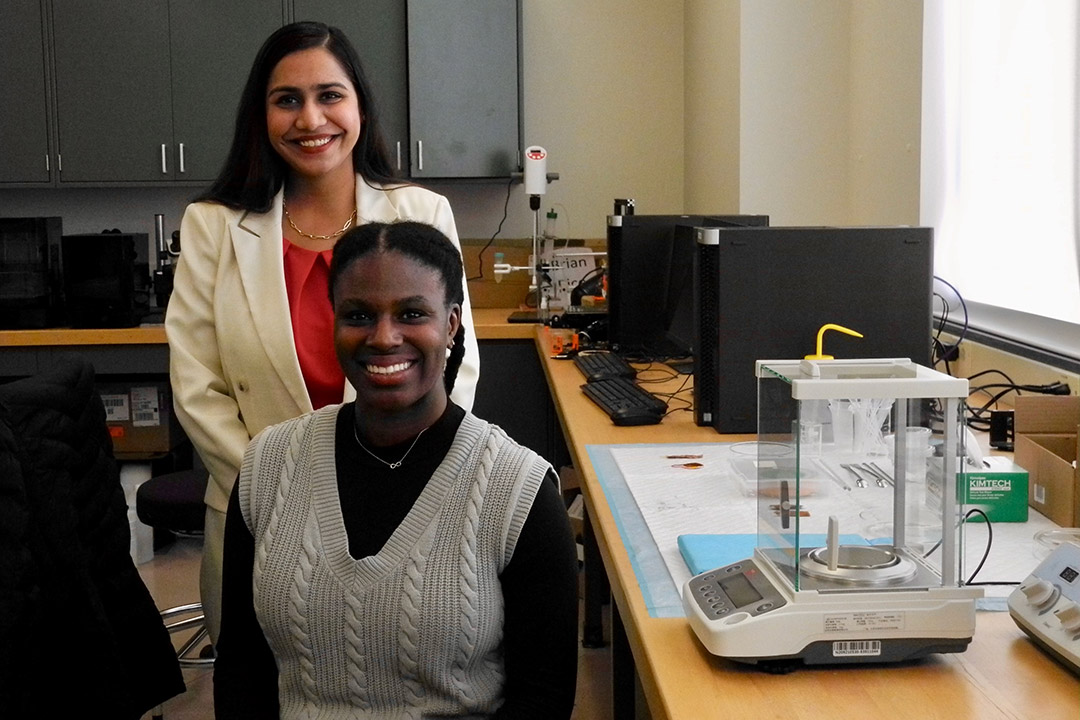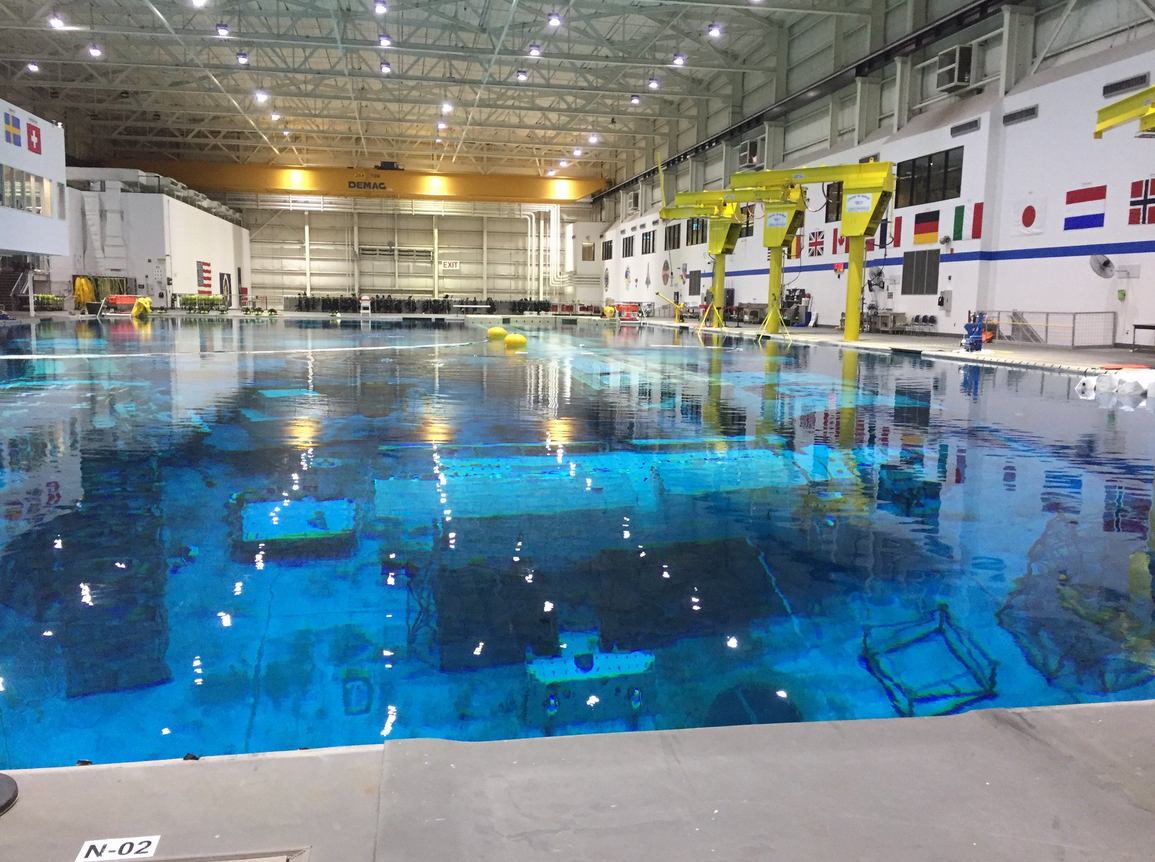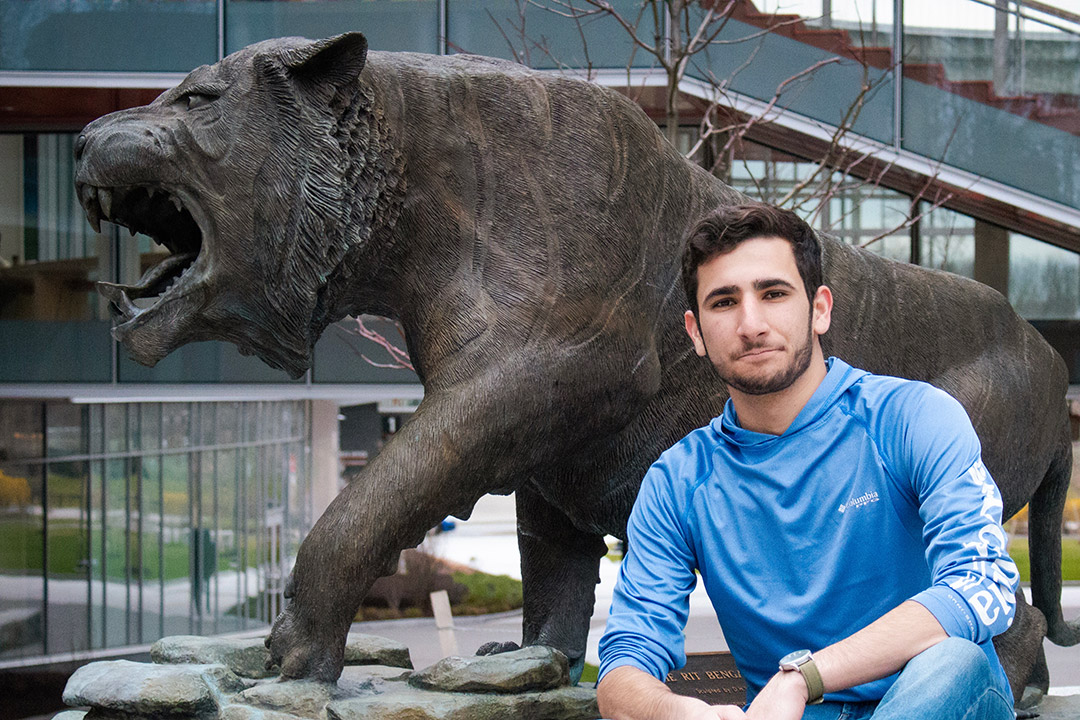Undecided to Unstoppable: An Alum's Drive to Innovate as a GM Manufacturing Process Engineer
Discover how an undecided RIT student found his calling in Mechanical Engineering Technology, graduated in '24, is now powering iconic vehicles as a Manufacturing Process Engineer at General Motors.
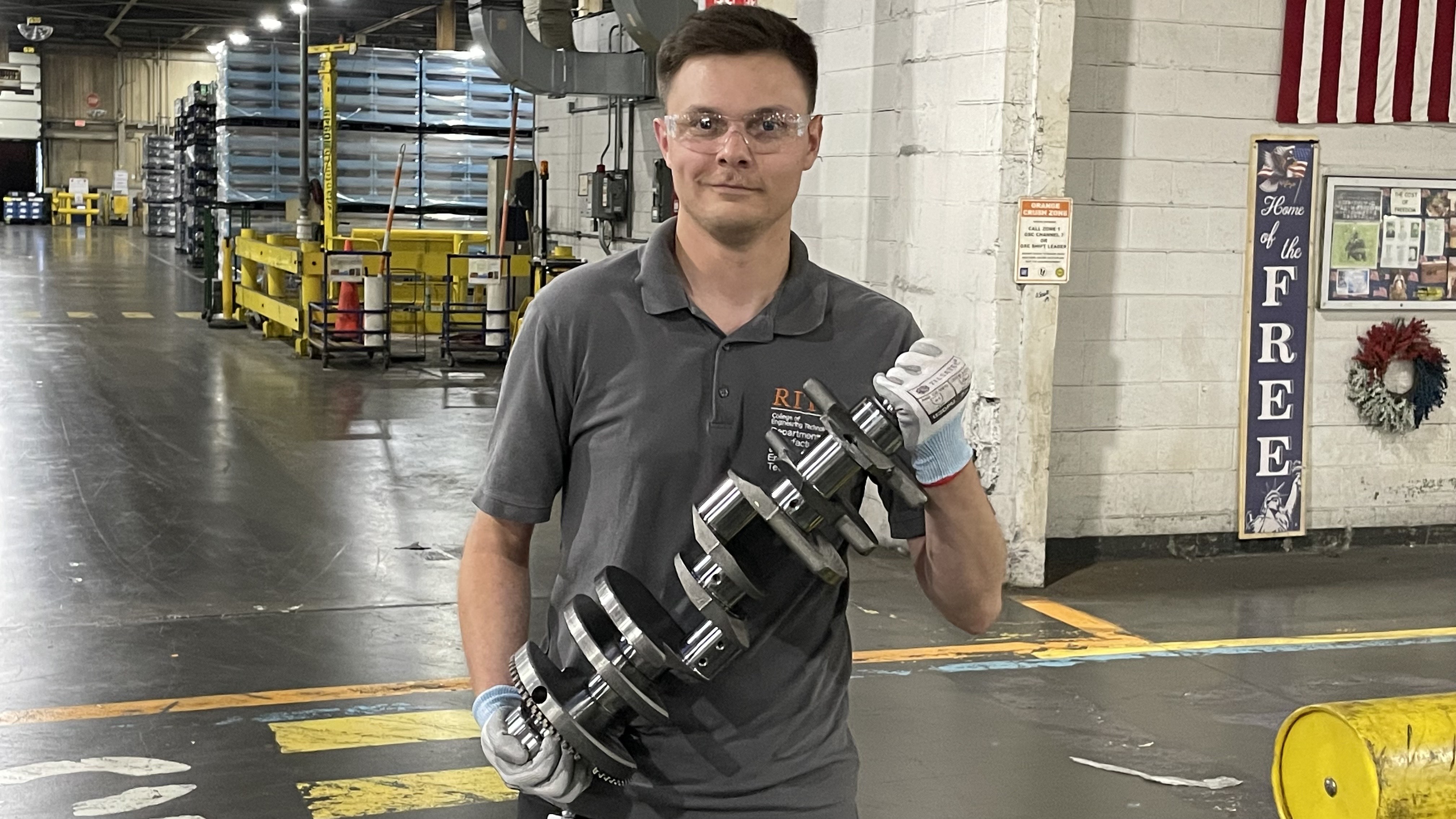
Dan Talbott ’24 (mechanical engineering technology) is a Manufacturing Process Engineer at General Motors in Buffalo, NY. He's an essential part of the team that builds engines for a variety of GM vehicles, including the Chevrolet Corvette. Dan's role focuses on keeping the production line running smoothly and ensuring top-notch quality, applying the "engineering mindset" he developed during his time at RIT.
What is your current employment (company, location and focus of role?)
I am currently employed as a Manufacturing Process Engineer at General Motors – Tonawanda Propulsion Systems, located in Buffalo, NY. Our facility is primarily responsible for the manufacturing and assembly of engines used in a wide range of GM vehicles, including trucks, SUVs, and even the Chevrolet Corvette. My role specifically focuses on the machining side of manufacturing. Some of my key responsibilities include maintaining a continuously operating production line and ensuring that all parts meet strict quality standards.
What do you think are the most important skills/abilities to have for this kind of work? Are there skills you learned at RIT that you apply to your job today?
The ability to think quickly is an essential skill in this environment, where minimizing downtime is a constant priority. Troubleshooting and resolving issues in real time are critical to maintaining an efficient and reliable production line. While I utilize a broad range of skills in my current role, the most valuable takeaway from my education at RIT was the development of an “engineering mindset.” Gaining a deep understanding of how systems function, accurately defining problems, formulating effective solutions, and verifying their success are all fundamental components of engineering practice—and are vital to succeeding in a fast-paced manufacturing setting.
What do you love about your current job? How did you discover the Mechanical ET program at RIT? What intrigued you about the program?
There is a strong sense of pride in the work we do. Our facility has been home to the Corvette engine since its inception, and this year we are proudly celebrating 70 years of the GM small block. The plant has a rich history, and GM continues to invest in its future. It is a unique and rewarding experience to see a vehicle on the road and know that you may have played a role in producing the major components that power it.
I started at RIT as an undeclared student, unsure of which path to take. Fortunately, RIT had a program that allowed me to explore different majors across several colleges, which was incredibly helpful. I quickly found myself gravitating toward the MCET courses—not only was I doing well in them, but I genuinely enjoyed the material. It only took one semester to realize I had found the right fit. I had taken Project Lead The Way (PLTW) courses in high school and immediately noticed the similarities. The hands-on, project-based learning style really clicked with me. I’ve always learned best by doing, and being able to apply concepts in a real-world setting helped everything make more sense. That combination of theory and practice is what really brought engineering to life for me.
Thinking back to your time at RIT, what are the top things from RIT that led you to where you are today? Were there any faculty that inspired you?
I had several impactful experiences outside the classroom that played a major role in shaping who I am today. One of the most significant was my involvement in Student Government, where I served as the CET Senator and Housing and Dining Committee Chair. This experience was instrumental in developing my leadership and interpersonal skills. While it’s not the traditional path many STEM students take, Student Government provided a unique opportunity to engage directly with both students and university administrators. It helped me become more confident in navigating professional environments where engineers are expected not only to excel technically, but also to communicate effectively with a wide range of individuals—from upper management to union-represented employees.
Another experience that defined my time at RIT—perhaps unexpectedly—was attending hockey games and becoming part of the Corner Crew. What started as a fun social activity with friends eventually became a personal growth journey. As I became more involved and eventually took on a leadership role within the group, I found myself stepping outside of my comfort zone and confronting social anxieties head-on. It was an environment that allowed me to grow while still having fun. The relationships I built and the confidence I gained through that experience have been incredibly valuable in the workplace, especially when it comes to building strong connections with coworkers.
I was also fortunate to learn from many inspiring faculty members at RIT—both in and outside of my core program. Professors Chris Lewis and Gary DeAngelis stand out in particular. They encouraged me to pursue a minor in Plastics Engineering Technology, which was not something I had considered when I first enrolled. Their enthusiasm and support pushed me to explore unfamiliar territory, and in doing so, I discovered a genuine love for learning and a desire to continue expanding my knowledge.
What made RIT stand out from other schools you could have gone to? Why the College of Engineering Technology?
I have always felt a strong connection to RIT, having grown up around campus. My mother has worked at the university for as long as I can remember. She is deaf and works within NTID, so from a young age, I was immersed in the Deaf community and culture. RIT is incredibly unique in its integration of Deaf and hearing cultures, creating a truly bilingual and inclusive campus. Even as a hearing student, there are countless opportunities to engage with Deaf culture and learn American Sign Language. Many of my friends were inspired to learn ASL during their time at RIT and developed a deep appreciation for the Deaf community. I can’t think of another university that blends these two worlds as seamlessly and meaningfully as RIT does.
As for the CET program, what drew me in—and kept me engaged—was its hands-on approach to learning. I’ve never been someone who thrives in lecture-heavy environments; instead, I’ve always understood complex concepts better when I could see them in action. The experiential learning style within CET helped solidify my understanding and made learning far more intuitive. That approach has translated directly to my professional life, where much of my work is hands-on and learning by doing is an everyday reality.
Were there any co-op or career services at RIT that helped you get started on your career? What were they? How did you learn about them?
RIT Career Services has played a significant role in shaping my career. From the beginning, they were always available to provide support—whether it was reviewing my résumé, offering interview tips, or guiding me through the co-op and job search process. One of the most valuable aspects of their support, though, was their extensive industry connections—an incredibly underutilized resource, in my opinion.
At one point, I was struggling to secure a second co-op and was hoping to stay in the Rochester area due to my ongoing Student Government commitments. Career Services connected me with the Golisano Institute for Sustainability, which was seeking an engineering co-op to support a remanufacturing project. That opportunity turned out to be my favorite co-op experience. I gained invaluable hands-on experience and benefited from outstanding mentorship, which significantly shaped my understanding of the field.
When it came time to apply for full-time positions, that co-op experience became the centerpiece of every interview. I was able to draw directly from the work I had done—particularly in the manufacturing sector—to secure a full-time role. Although I learned about Career Services during my first semester, I didn’t start taking full advantage of their resources until after my first co-op. Looking back, I only wish I had reached out to them sooner.
What did you like in high school? How did you choose your RIT degree? What advice would you give to high school students who would like to pursue this field?
As I mentioned earlier, I took several Project Lead The Way (PLTW) courses in high school and was also a proud member of a FIRST Robotics team (go Team 340!). On paper, it may have seemed like I was headed straight for a career in engineering—but the truth is, I wasn’t entirely sure what I wanted to do when I first arrived at RIT. It took some time and exploration before I found my place in the MCET program, and I’m grateful that I had the opportunity to try different paths before settling into the one that was right for me.
For prospective students, my biggest piece of advice is this: don’t be afraid to try new things, and don’t hesitate to change direction if something isn’t working for you. College is the best time to explore your interests and figure out what you truly enjoy—and just as importantly, what you don’t. It’s far better to make those discoveries early on than to find yourself halfway through your degree feeling uncertain about your path.
Do you have any additional comments or advice you would like to share?
I would say that your four to five years of college are some of the best of your life—so make sure to enjoy them! Don’t get too caught up in classes or obsessing over the perfect grade. Take time to pursue activities you enjoy and be open to trying new things. RIT is an incredible place to explore who you are and discover your passions. Don’t miss out on the many opportunities available to you!
